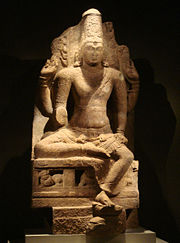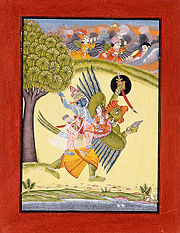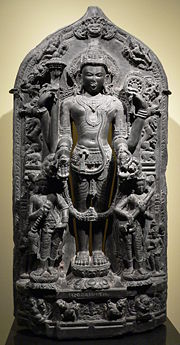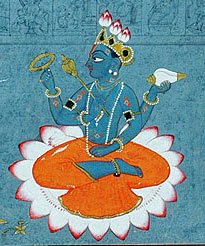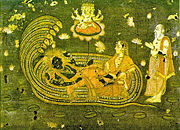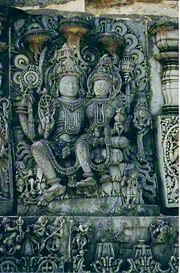Vishnu
2008/9 Schools Wikipedia Selection. Related subjects: Divinities
| Vishnu | |
 |
|
| Preservation / Supreme God | |
| Devanagari | विष्णु |
|---|---|
| Affiliation | Trimurti |
| Abode | Vaikuntha |
| Weapon | Sudarshana Chakra and the Kaumodaki |
| Consort | Lakshmi |
| Mount | Garuda |
| Planet | Vaikuntha |
Vishnu ( IAST viṣṇu, Devanagari विष्णु), (honorific: Sri Vishnu) also known as Narayana, is the Supreme Being (i.e., God ) or Ultimate Reality for Vaishnavas and a manifestation of Brahman in the Advaita or Smarta traditions of Hinduism.
The Vishnu Sahasranama describes Vishnu as the All-Pervading essence of all beings, the master of and beyond the past, present and future, the creator and destroyer of all existences, one who supports, sustains and governs the Universe and originates and develops all elements within.
In the Puranas, Vishnu is described as being the colour of clouds (dark-blue), four-armed, holding a lotus, mace, conch and chakra (wheel). Vishnu is also described in the Bhagavad Gita as having a 'Universal Form' ( Vishvarupa) which is beyond the ordinary limits of human sense perception .
It is also within the Puranas that the information regarding Vishnu's avatars is given. Nine of these avatars, or 'incarnations' are described as having occurred in the past, with one still to happen at the end of Kali Yuga. The Bhagavad Gita mentions their purpose as being to rejuvenate Dharma and vanquish negative forces. In virtually all the Sanatana Dharma traditions, Vishnu is worshipped, either directly or through avatars such as Rama, Krishna, Varaha and Narasimha.
In the Trimurti, Vishnu is responsible for the maintenance or 'preservation' of the Universe, with the other roles of creation and destruction being under the care of Brahma and Shiva, respectively.
Etymology
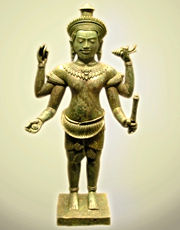
The traditional Sanskrit explanation of the name Viṣṇu involves the root viś, meaning "to settle, to enter", or also (in the Rigveda) "to pervade", and a suffix nu, translating to approximately "the All-Pervading One". An early commentator on the Vedas, Yaska, in his Nirukta, defines Vishnu as 'vishnu vishateh; one who enters everywhere', and 'yad vishito bhavati tad vishnurbhavati; that which is free from fetters and bondages is Vishnu.'
Adi Sankara in his commentary on Vishnu Sahasranama states derivation from this root, with a meaning "presence everywhere" ("As he pervades everything, vevesti, he is called Visnu"). Adi Sankara states (regarding Vishnu Purana, 3.1.45): "The Power of the Supreme Being has entered within the universe. The root Viś means 'enter into.'" Swami Chinmayananda, in his translation of Vishnu sahasranama further elaborates on that verse: The root Vis means to enter. The entire world of things and beings is pervaded by Him and the Upanishad emphatically insists in its mantra "whatever that is there is the world of change." Hence, it means that He is not limited by space, time or substance. Chinmayananda states that which pervades everything is Vishnu.
Regarding the suffix, Manfred Mayrhofer proposes that the nasal is analogous to jiṣṇu "victorious". Mayrhofer further suggests that the name goes back to an already Indo-Iranian *višnu, and was replaced by rašnu in Zoroastrian Iran.
The root viś is also associated with viśva "all" (possibly by popular etymology, the word is generally believed to derive from Indo-Iranian *vi-k'o-, influenced by sarva "all", but a minority opinion does, indeed, derive viśva as from vik'-so, (J. Knobloch (1980)).
Suggestions involving other roots include vi-ṣṇu "crossing the back", vi-ṣ-ṇu "facing towards all sides" and viṣ-ṇu "active", as well as attempts to explain Vishnu as a combination of two unrelated words, or as being derived from a non-Aryan root The name is continued in Prakrit veṇhu, viṇhu.
Vishnu in Smriti and Shruti
In the Vedas
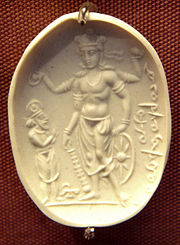
In the Rigveda, Vishnu is mentioned 93 times. He is frequently invoked alongside other deities, especially Indra, whom he assists in killing Vritra, and with whom he drinks Soma. His companionship with Indra is still reflected by his later titles Indrānuja and "Upendra", both referring to Vishnu as being the brother of Indra. His distinguishing characteristic in the Vedas is his association with Light, or even his identification with the Sun.
The most celebrated act of Vishnu in the Rigveda is the 'three steps' by which he strode over this (universe) and in three places planted his step. The 'Vishnu Sukta' of the Rig Veda (1.154) says that the first and second of Vishnu's strides (those encompassing the earth and air) are visible to men and the third is in the heights of heaven (sky). This last place is described as Vishnu's supreme abode in RV 1.22.20:
- The princes evermore behold / that loftiest place where Visnu is / Laid as it were an eye in heaven. (trans. Griffith)
Griffith's "princes" are the sūri, either "inciters" or lords of a sacrifice, or priests charged with pressing the Soma. The verse is later quoted as expressing Vishnu's supremacy by Vaishnavites,
(In the Rigveda the Sun is not a high-ranking deity, c.f. e.g. RV 2.12.7,
- He who gave being to the Sun and Morning, who leads the waters, he, O men, is Indra. (trans. Griffith)
where Indra appears as senior to the Sun.)
One early commentator, Aurnavabha, who is mentioned by Yaska in his Nirukta, interprets the three steps as the different positions of the sun at his rising, culmination, and setting. Though such solar aspects have been associated with Vishnu by tradition as well as modern-scholarship, he was not just the representation of the sun for in Rigveda he traverses in his strides both vertically and horizontally.
In hymns I.22.17, 1.154.3, 1.154.4 he strides across the earth with three steps, in VI.49.13 , VII.100.3 strides across the earth three times and in I.154.1,I.155.5,VII.29.7 he strides vertically, with the final step in the heavens. The same Veda also says he strode wide and created space in the cosmos for Indra to fight Vritra. By his stride he said to have made dwelling for men possible, the three being a symbolic representation of its all-encompassing nature. This all-enveloping nature, assistance to Indra and benevolence to men were to remain the enduring attributes of Vishnu. As the triple-strider he is known as Tri-vikrama and as Uru-krama for the strides were wide. (The reference to the three strides of Vishnu in the Rig Veda is most possibly a prototype for the later legend of Vamana.)
In the Vedas, Vishnu appears not yet included in the class of the Adityas (unless it is implied that he is identical with Surya, and included as the eighth Aditya), but in later texts he appears as heading them.
It is inexplicable how Vishnu (and Shiva) rose to the prominence enjoyed currently by referring only to the Vedic hymns as Indra and Agni are invoked far more. It must be remembered that these hymns are liturgical in nature and meant primarily for the Soma sacrifice, especially dear to Indra. They may not represent the popular religion of those times as Jan Gonda cautions. Gonda also gives an elaborate theory of how the notion of Vishnu spread over various hymns contains the germs of future attributes. In some Rigvedic hymns, Indra seeks the help of Vishnu in destroying Vritra, indicating that he is not sufficient to accomplish it on his own.
In another interpretation, the characteristic of Vishnu as the Supreme God appeared much earlier in the Vedic texts. For example, the following Vedic hymns express that point of view:
1. Purusha Sukta of Taittiriya Aranyaka (3.13.2) also refers master of Hri and Lakshmi (Vishnu) as Purusha, the Supreme God.
2. Visvakarma Sukta of Rig Veda (10.82) refers to Vishnu indirectly as the Supreme God.
- 10.082.06: The waters verily first retained the embryo in which all the gods were aggregated, single deposited on the navel of the unborn (creator), in which all beings abide. The reference to the navel of the unborn is an indication of reference to Vishnu.
3. The Rig Veda (1.22.20) states, oṃ tad viṣṇoḥ paramam padam sadā paśyanti sūrayaḥ: "All the suras (i.e., the devas) look always toward the feet of Lord Vishnu."
There are also hymns in Rigveda which describe Vishnu as Jagathkartha -meaning 'he who created everything'.
The foreword of P. Sankaranarayan's translation of Vishnu sahasranama, Bhavan's Book University, cites Rig Veda V.I.15b.3, for the importance of chanting Vishnu's name, "O ye who wish to gain realization of the supreme truth, utter the name of Vishnu at least once in the steadfast faith that it will lead you to such realization."
- Agni is the lowest among devatas and Vishnu is the highest. All other devatas except Lord Vishnu and Agni Deva occupy positions between them. A similar view of Agni as the youngest deity and Vishnu as the oldest deity, in one interpretation, is even expressed in the Chamakam, the last lines in the famous Saivite Vedic hymn, Shri Rudram.
In the Brahmanas
By the age of the Brahmanas, various stories can be found associating Vishnu with the act of religious sacrifice ( Yajna). The sacrifice being the core of interest for these texts, this association goes a long way in explaining the importance of Vishnu. How this association came about is not clear, but the various stories in the Brahmanas seem to explain a fait accompli. Vishnu is said to have become the most important of all gods by truly 'understanding' the meaning of the sacrifice before all else. In the Shatapatha Brahmana, he is described as winning the sacrifice back from Asuras as a dwarf, where the kernel of the Vamana incarnation can be seen. Aitareya Brahmana: 1:1:1 mentions Vishnu as the Supreme God.
In the Upanishads
The Upanishads that form the philosophical culmination of the Vedas are dated at approximately 900 BCE. The purportedly oldest of these texts are the Chhandogya and Brhadaranyaka Upanishads. The former does not name Vishnu and the latter mentions him as part of ritual to obtain an exceptionally wise and learned son along with other deities. The slightly later Katha-upanishad, however, describes Vishnu in prominence -
He who has no understanding, who is unmindful and always impure, never reaches that place, but enters into the round of births. But he who has understanding, who is mindful and always pure, reaches indeed that place, from whence he is not born again. But he who has understanding for his charioteer (intellect), and who holds the reins of the mind, he reaches the end of his journey, and that is the highest place of Vishnu.
His rise to supremacy is apparent in the epics (Mahabharata, Ramayana, and from this period he may be considered a manifestation of the Singular God. Thus, according to this interpretation, the division in Hinduism of Vaishnavism and Shaivaism appeared only with the Puranas, where Vishnu's descents in ten principal Avatars become his distinguishing characteristic.
In the Bhagavad Gita
In the Bhagavad Gita the avatara Krishna teaches Arjuna the nature of the Supreme being and the different processes of Yoga, ultimately culminating in devotional surrender:
- "I am the goal, the sustainer, the master, the witness, the abode, the refuge, and the most dear friend. I am the creation and the annihilation, the basis of everything, the resting place and the eternal seed."
- "But what need is there, Arjuna, for all this detailed knowledge? With a single fragment of Myself I pervade and support this entire universe."
- "If hundreds of thousands of suns were to rise at once into the sky, their radiance might resemble the effulgence of the Supreme Person in that universal form."
- "Abandon all varieties of religion and just surrender unto Me. I shall deliver you from all sinful reactions. Do not despair."
Theological attributes
Vishnu takes form as an all-inclusive deity, known as Purusha or Mahāpurusha, Paramātma [Supreme Soul], Antaryāmi [In-dweller], and he is the Sheshin [Totality] in whom all souls are contained. He is Bhagavat or Bhagavan, which in Sanskrit means "possessing bhāga (Divine Glory)".
Vishnu possesses six such divine glories, namely,
- Jñāna Omniscient; defined as the power to know about all beings simultaneously;
- Aishvarya Sovereignty, which persist in unchallenged rule over all;
- Shakti Energy, or power, which is the capacity to make the impossible possible;
- Bala Strength, which is the capacity to support everything by his will and without any fatigue;
- Virya Vigour, or valour which indicates the power to retain immateriality as the Supreme Spirit or Being in spite of being the material cause of mutable creations;
- Tèjas Resplendent, or Splendour, which expresses his self-sufficiency and the capacity to overpower everything by his spiritual effulgence; cited from Bhakti Schools of Vedanta, by Swami Tapasyananda.
However, the actual number of auspicious qualities of Vishnu is countless, with the above-mentioned six qualities being the most important. Other important qualities attributed to Vishnu are Gambhirya (inestimatable grandeur), Audarya (generosity), and Karunya (compassion.)
The Rigveda says: Vishnu can travel in three strides. The first stride is the Earth. The second stride is the visible sky. The third stride cannot be seen by men and is the heaven where the gods and the righteous dead live. (This feature of three strides also appears in the story of his avatar Vamana called Trivikrama.) The Sanskrit for "to stride" is the root kram; its reduplicated perfect tense is chakram ( guņa grade) or chakra ( zero-grade), and in the Rigveda he is called by epithets such as vi-chakra-māņas = "he who has made 3 strides". The Sanskrit word chakra also means "wheel". That may have suggested the idea of Vishnu carrying a chakra.
Three forms
In Gaudiya Vaishnavism, a school of Vaishnavism, the Satvata-tantra describes three different forms, or aspects, of Vishnu as Maha Vishnu, Garbhodaksayi Vishnu and Kshirodakasayi Vishnu, with each form having a different role in the maintenance of the Universe and its inhabitants:
"For material creation, Lord Krishna's plenary expansion assumes three Vishnus. The first one, Maha-Vishnu, creates the total material energy, known as the mahat-tattva. The second, Garbhodakasayi Vishnu, enters into all the universes to create diversities in each of them. The third, Kshirodakasayi Vishnu, is diffused as the all-pervading Supersoul in all the universes and is known as Paramatma. He is present even within the atoms. Anyone who knows these three Vishnus can be liberated from material entanglement."
Five forms
In Srivaishnavism, another school, Vishnu assumes five forms:
- In the Para Form, Para is the highest form of Vishnu found only in Sri Vaikunta also called Moksha, along with his consorts Lakshmi, Bhuma Devi and Nila and surrounded by liberated souls like Ananta, Garuda, and a host of Muktas (liberated souls).
- In the Vyuha form which itself divides into four, Vishnu assumes four forms, which exercise different cosmic functions and controls activities of living beings.
- In the Vibhava form, Vishnu assume various manifestations, called Vibhavas, more popularily known as Avataras from time to time, in order to protect the virtuous, punish the evil-doers and re-establish righteousness.
- In the Antaryami or "Suksma Vasudeva" form, Vishnu exists in a very subtle from, alongside the souls of all living beings and in every atom of matter.
- In the Arcavatara or Image manifestation, the Lord is easily approachable to the devotees since they cannot worship Para, Vyuha, Vibhava and Antaryami forms directly, which can only be imagined or meditated upon because they are beyond our reach. Such images can be
- revealed by the Lord himself, for example, Tirumala Venkateswara Temple, Sri Ranganathaswamy Temple at Srirangam; or
- installed by devas or celestial beings such as Guruvayur Temple installed by Vayu; or
- installed by humans, and consecrated according to Vaishnava Agama shastras or scriptures such as Lord Jagannath of Jagannath Temple (Puri) at Puri.
Relations with other Deities
Vishnu's consort is Lakshmi, the Goddess of wealth. Maya is the samvit (the primary intelligence) of Vishnu, while the other five attributes emerge from this samvit and hence Maya is his ahamata, activity, or Vishnu's Power. This power of God, Maya, is personified and is called Maya, Vishnumaya, or Mahamaya, and She is said to manifest Herself in, 1) kriyāshakti, (Creative Activity) and 2) bhütishakti (Creation) of Universe. Hence this world cannot part with his creativity i.e., ahamta, which is a feminine form and is called Maya.
Vishnu is also associated with Bhudevi or Prithvi, the earth goddess; Tulsi; Ganga, goddess of river Ganges and also Saraswati, goddess of learning. In the Brahma Vaivarta Purana, verses 2.6.13-95 it is described that Vishnu has three wives, who constantly quarrel with each other, so that eventually, he keeps only Lakshmi, giving Ganga to Shiva and Saraswati to Brahma.
Vishnu's vehicle is Garuda, the eagle, and he is commonly depicted as riding on his shoulders.
Iconography
According to various Purana, Vishnu is the ultimate omnipresent reality, is shapeless and omnipresent. However, a strict iconography governs his representation, whether in pictures, icons, or idols:
- He is to be depicted as a four-armed male-form: The four arms indicate his all-powerful and all-pervasive nature. The physical existence of Vishnu is represented by the two arms in the front while the two arms at the back represent his presence in the spiritual world. The Upanishad titled Gopal Uttartapani describes the four arms of Vishnu.
- The color of his skin has to be new-cloud-like-blue: The blue color indicates his all-pervasive nature, blue being the colour of the infinite sky as well as the infinite ocean on which he resides.
- He has the mark of sage Bhrigu's feet on his chest.
- Also on his chest is the srivatsa mark, symbolising his consort Lakshmi.
- Around his neck, he wears the auspicious " Kaustubha" jewel, and a garland of flowers (vanamaalaa).
- A crown should adorn his head: The crown symbolizes his supreme authority.
- He is to shown wearing two earrings: The earrings represent inherent opposites in creation - knowledge and ignorance; happiness and unhappiness; pleasure and pain.
- He rests on Ananta: the immortal and infinite snake
Vishnu is always to be depicted holding the four attributes associated with him, being:
- A conch shell or Shankhya, named "Panchajanya", held by the upper left hand, which represents creativity. The Panchajanya is the originator of the five elements or Panchabhoota - water, fire, air, earth and sky or space. The sound that evolves from blowing this conch is the primeval sound of creation.
- The chakra, a sharp-spinning discus-like weapon, named " Sudarshana", held by the upper right hand, which symbolizes the mind. The name Sudarshana is derived from two words - Su, which means good, and Darshan, which means vision. The chakra as a weapon thus indicates the necessity of destroying one's ego and illusory self-existence and developing the vision to identify the eternal truth. The discus has six spokes and symbolizes a lotus with six petals, thus representing the power that controls all six seasons.
- A mace or Gada, named " Kaumodaki", held by the lower left hand, which represents individual existence. The mace symbolizes the primeval force from which all mental and physical strength is derived.
- A lotus flower or Padma, held by the lower right hand, which represents liberation or dispersion. The lotus symbolizes the power from which the universe emerges. It represents the concentration of truth or Satya, the originator of the rules of conduct or Dharma, and knowledge or Gyana in a single symbol.
To this may be added, conventionally, the vanamaala flower garland and Vishnu's bow, the Shaarnga, and his sword Nandaka. Vide "vanamālī gadhī shārngī shanki chakri cha nandaki / shrīmān nārāyaņo vişņo vāsudevo abhirakşatu//"
In general, Vishnu is depicted in one of the following three ways:
- Standing upright on a lotus flower, often with Lakshmi, his consort, beside him on a similar pedestal;
- Reclining on the coiled-up thousand-hooded Shesha Naga, with his consort Lakshmi, seated at his feet; the assemblage rests on the "Kshira Sagar" (ocean of Milk). In this representation, Brahma is depicted as sitting on a lotus that grows out of Vishnu's navel.
- Riding on the back of his eagle mount, known as Garuda.
Avatars
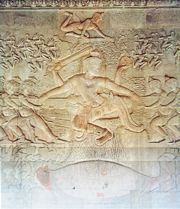
There are ten avatars of Vishnu (dashavatara) commonly considered as the most prominent:
- Matsya, the fish.
- Kurma, the turtle.
- Varaha, the boar.
- Narasimha, the Man-Lion (Nara = man, simha = lion).
- Vamana, the Dwarf Brahmin (priest).
- Parashurama, Rama with the axe, who appeared in the Treta Yuga.
- Rama, Sri Ramachandra, the prince and king of Ayodhya.
- Krishna (meaning 'dark coloured' or 'all attractive') appeared in the Dwapara Yuga along with his brother Balarama. Balarama is included as the eighth or ninth Dasavatara in some versions of the list which either contain no reference to Buddha, or list Krishna as the source of all avatars.
- Buddha (meaning 'the enlightened one') appeared in the Kali Yuga (specifically as Siddhartha Gautama).
- Kalki ("Eternity", or "time", or "The Destroyer of foulness"), who is expected to appear at the end of Kali Yuga, the time period in which we currently exist.
Some versions of the above list include Hayagriva amongst the Dasavataras.
Apart from the above mentioned ten principal avatars, another 22 avatars are given in Chapter 3, Canto 1 of the Srimad Bhagavatam. Following this list the Bhagavatam states that as well as these avatars "the incarnations of the Lord are innumerable, like rivulets flowing from inexhaustible sources of water".
There has also been some comparison between the avatars of Vishnu and Darwin's Theory of Evolution, as the incarnations generally mirror increasing phylogenetic sophistication in keeping with the theory's proposal of terrestrial reptiles and mammals evolving from aquatic and amphibian life.
Thousand names of Vishnu
Vishnu has a large number of names, collected in the Vishnu sahasranama ("Vishnu's thousand names") from within the larger work Mahabharata. The character Bhishma recites the names before Krishna on the battlefield of Kurukshetra, praising him (Vishnu) as the Supreme God. These Sahasranama are regarded as essence of all Vedas by followers of Vaishnavism who believe sincere chanting of Vishnu Sahasranama results in spiritual well-being and a greater awareness of God.
The names are generally derived from the anantakalyanagunas (meaning: infinite auspicious attributes). Some names are:
- Acyutah (infallible)
- Ananta (endless, eternal, infinite)
- Damodara (having a rope (dama) around his belly (udara): a name of Krishna)
- Govinda (protector of the cows & brahmins; master of the senses: a name of Krishna)
- Hari (one who takes away)
- Hayagriva (giver of knowledge)
- Jagannatha (Owner/Ruler of the world/universe)
- Janardana (One who is worshiped by people for Wealth)
- Kesava (slayer of Keshi, having long or much or handsome hair, from Atharvaveda viii , 6 , 23)
- Krishna (born during the third epoch or yuga, his deeds range from cow protection (go rakshya) to absolving the earth of load of sins)
- Madhava (relating to the season of spring)
- Madhusudana (he who destroyed the demon called Madhu)
- Narayana (said to mean "he who is the abode of nār (= ether)", i.e., the whole world's shelter. There are two more meanings of Narayana found in a stuti of child- Krishna by Brahma).
- Padmanabha (lotus-naveled one, from whose navel sprang the lotus which contained Brahma, who created the universe)
- Perumal Name he is known in Tamil
- Purushottama - The Supereme Eternal Being
- Rama (born during the second epoch of yuga, his deeds primarily established the ideal living principles of a man)
- Hrishikesh (lord of the senses)
- Satyanarayana (a combination of satya and Narayana meaning 'protector of truth')
- Sridhara (consort of Sri = Laxmi or Ultimate wealth)
- Siddhartha (one who attains perfection, birth name of Buddha avatar in the last epoch of Kali Yuga)
- Sriman (the pride of Shri or Lakshmi); Often Sriman is combined with the name, Narayana , to form a compound word, Sriman Narayana.
- Srinivasa (the abode of Shri) (also specifically referring to his form in the temple at Tirupati). Also the form of Vishnu at Tirupati is well-known as Venkateswara.
- Thrivikrama (Conqueror of the three worlds, as in vamana avatara).
- Vishal (Immense, The Unstoppable One).
- Vamana (dwarfish, small or short in stature, a dwarf brahmana)
- Vāsudeva ( "All-Pervading God", with the long vowel A;it means "the son of Vasudeva": a name of Krishna)
